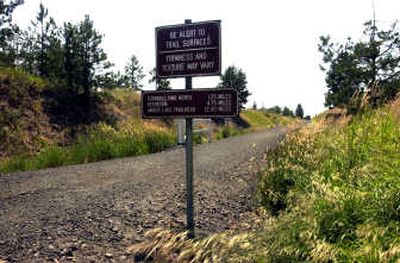Fish Lake Trail moves closer to completion

Completion of a missing link in the Inland Northwest’s bike and pedestrian trail system took a jump forward last week when the Spokane City Council approved a major design contract for an 11-mile trail segment between Spokane and Fish Lake near Cheney.
When completed in two to four years, the trail would allow users to connect between the Centennial Trail in Spokane and Kootenai counties and the Columbia Plateau Trail, which runs on former railroad right of way from Fish Lake to Tri-Cities.
The Fish Lake Trail has been a dream of recreational users and Spokane officials since the city acquired former Union Pacific Railroad right of way in 1991.
“It’s a phenomenal project,” said Spokane Councilman Brad Stark, predicting that the additional trail segment will make the Inland Northwest a biking capital by filling a gap between existing trail segments in the Columbia Basin and Spokane-Coeur d’Alene regions.
“It’s going to be great for enhancing quality of life,” Stark said.
On Nov. 6, Stark and other members of the council approved a $572,000 contract with David Evans and Associates Inc. for detailed work on design, environmental issues and construction permits. The David Evans firm operates throughout the West and in New York and has a Spokane office.
Nine years ago, the city spent about $300,000 to pave some of the less difficult sections of the right of way near Scribner Road in Spokane County.
However, the undeveloped segments of the route pose serious obstacles, including the need to cross two live rail lines at the southwest end of Queen Lucas near Marshall.
A pair of feasibility studies done two years ago recommended building a pair of overpass trail bridges to cross the rail lines at a location known as UP Junction. The railroads want at least 23 feet of overhead clearance, which means the bridges would have to be long enough to reach that height at a fairly gentle grade. They would also have to fit within the constraints of the surrounding terrain, which is fairly rocky, officials said. Cost of the bridges was preliminarily estimated at about $3 million.
In addition, the trail has a series of smaller rail bridges on the northeast end of the right of way, including a crossing over Interstate 90 near Government Way and Sunset Boulevard.
Katherine Miller, senior engineer for capital projects for the city, said that with the need for bridges the biggest issue facing the project is funding.
Cost for completion of the trail is estimated at $6 million. Stark and other local officials have said they want to raise $4 million in state and federal transportation grants and combine that with $2 million to be raised locally, in part with private donations.
The state already has granted $1 million for future construction, Miller said. Getting another $1 million from the state appears to be possible, but federal transportation money for trails is only available periodically, she said.
The city is paying for planning through a previous federal grant along with city funds set aside for bike trail development, she said.
One suggestion is to use the limited money available now for a trailhead and trail segment on the Spokane end of the right of way to generate publicity and get public support for additional funding.
“We want to build momentum,” Miller said.
Miller said designers are expected to meet again with railroad officials to work through safety issues and the details of the proposed bridges. Approval by BNSF Railway Co. and Union Pacific railroads is critical to extending the trail southwest from Scribner Road to Fish Lake, she said.
“Obviously, there are some serious safety issues,” she said.
Solving those problems would open a stretch of wild scabland at Queen Lucas Lake that rivals any of the scenery along the Centennial Trail.
Miller said that if funding or safety issues can’t be resolved, then the trail could be built from Spokane to the vicinity of Scribner Road at Cheney-Spokane Road. The trail could then be routed along Cheney-Spokane Road to Fish Lake, where it would connect with the state’s Columbia Plateau Trail.
The section between Scribner Road and Fish Lake is not considered safe for travel because of the rail crossings. Also, going onto BNSF property is considered trespassing.
On the Spokane end of the trail, the city has already built trail routes down Government Way and West Riverside Avenue into High Bridge Park, which connects the Fish Lake Trail with the Centennial Trail at the Sandifur pedestrian bridge in High Bridge Park.
The trail system will run next to a proposed whitewater park on the Spokane River at High Bridge Park.
Grass-roots work by the Bicycle Alliance of Washington, the REI outdoor equipment store in Spokane and the Fish Lake Trail Action Group has put steam into the rails-to-trail project in recent years.
Earlier this year, volunteers built a temporary trail head in Spokane where Lindeke Street and Lindeke Court merge, a short distance south of Sunset Boulevard and Government Way.